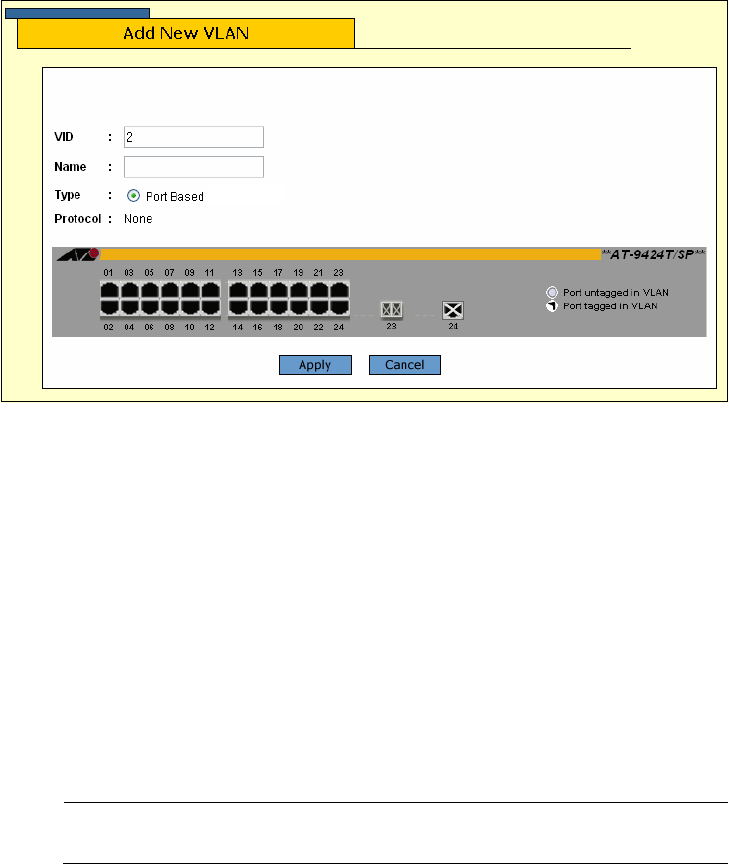User guide
Table Of Contents
- Contents
- Figures
- Tables
- Preface
- Section I
- Basic Operations
- Chapter 1
- Basic Switch Parameters
- Configuring the Switch’s Name, Location, and Contact
- Changing the Manager and Operator Passwords
- Setting the System Date and Time
- Rebooting a Switch
- Pinging a Remote System
- Returning the AT-S63 Management Software to the Factory Default Values
- Displaying the IP Address of the Local Interface
- Displaying System Information
- Chapter 2
- Port Parameters
- Chapter 3
- Enhanced Stacking
- Chapter 4
- SNMPv1 and SNMPv2c
- Chapter 5
- MAC Address Table
- Chapter 6
- Static Port Trunks
- Chapter 7
- Port Mirroring
- Section II
- Advanced Operations
- Chapter 8
- File System
- Chapter 9
- File Downloads and Uploads
- Chapter 10
- Event Logs and Syslog Client
- Chapter 11
- Classifiers
- Chapter 12
- Access Control Lists
- Chapter 13
- Class of Service
- Chapter 14
- Quality of Service
- Chapter 15
- Denial of Service Defenses
- Chapter 16
- IGMP Snooping
- Section III
- SNMPv3
- Chapter 17
- SNMPv3
- Configuring the SNMPv3 Protocol
- Enabling or Disabling SNMP Management
- Configuring the SNMPv3 User Table
- Configuring the SNMPv3 View Table
- Configuring the SNMPv3 Access Table
- Configuring the SNMPv3 SecurityToGroup Table
- Configuring the SNMPv3 Notify Table
- Configuring the SNMPv3 Target Address Table
- Configuring the SNMPv3 Target Parameters Table
- Configuring the SNMPv3 Community Table
- Displaying SNMPv3 Tables
- Section IV
- Spanning Tree Protocols
- Chapter 18
- Spanning Tree and Rapid Spanning Tree Protocols
- Chapter 19
- Multiple Spanning Tree Protocol
- Section V
- Virtual LANs
- Chapter 20
- Port-based and Tagged VLANs
- Chapter 21
- GARP VLAN Registration Protocol
- Section VI
- Port Security
- Chapter 22
- MAC Address-based Port Security
- Chapter 23
- 802.1x Port-based Network Access Control
- Section VII
- Management Security
- Chapter 24
- Encryption Keys, PKI, and SSL
- Chapter 25
- Secure Shell (SSH)
- Chapter 26
- TACACS+ and RADIUS Protocols
- Chapter 27
- Management Access Control List
- Index

Chapter 20: Port-based and Tagged VLANs
320 Secton V: Virtual LANs
untagged ports of the VLAN.
For example, if a particular port is listed as a Configured member
of a VLAN, but not as an Actual member, that would mean either
the port is currently a part of a Guest VLAN or the supplicant who
logged on the port was associated with a VLAN assignment on the
authentication server.
4. To add a new VLAN, click Add.
The Add New VLAN page is shown in Figure 129.
Figure 129. Add New VLAN Page
5. Configure the following parameters as necessary.
VID
Enter a VID value for the new VLAN. The range of the VID value is 2 to
4096. The default is the next available VID number on the switch.
If this VLAN is unique in your network, then its VID should also be
unique. If this VLAN is part of a larger VLAN that spans multiple
switches, then the VID value for the VLAN should be the same on
each switch. For example, if you are creating a VLAN called Sales that
spans three switches, you should assign the Sales VLAN on each
switch the same VID value.
Note
A VLAN must have a VID.
The switch is only aware of the VIDs of the VLANs on the device and
not those already being used in the network. For example, if you add a
new AT-9400 Series switch to a network where the existing VLANs










